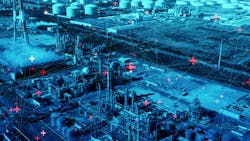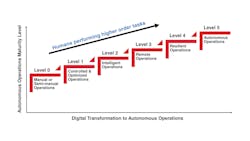Beyond automation: Moving to industrial autonomy
Automated processes and modern industrial control systems have transformed refining and petrochemical plants in recent decades. Building on established principles from fluid mechanics, equilibrium operations, kinetics and catalysis, engineers have benefited from more sophisticated tools for designing and operating safe and efficient plants.
Early numerical computing devices, such as slide rules and calculators have given way to mainframe computers and eventually to today’s chemical engineering design and simulation applications. Operations, meanwhile, have moved from manual processes to automated, controlled and intelligent processes and remote control.
That should not be the end of the journey, however. We can, in fact, chart the potential technology journey – from manual processes (level 0) to fully autonomous operations (level 5).
However, progressing through the levels requires overcoming several challenges — many of them linked to the decreasing reliance on people to operate the plant and, conversely, the increasing demands on those who remain. Fortunately, there are several technologies that can help.
It is worth examining both the challenges and opportunities.
Connecting the dots: Cross-domain linkages
First, efficient and safe processes require the ability to identify and act on cross-domain linkages: effectively interpreting signals from one part of the plant or process and the consequences they may have for another.
In manual operations, this relies, to a large extent, on the observations of personnel and their ability to draw the correct conclusions from these. It might be as simple as field operators noticing a noisy bearing on rotating equipment. Linking this in a timely fashion to declining performance or required maintenance could be critical to preventing unplanned downtime or even a safety incident.
Likewise, cross-functional linkages are also essential to plant performance, and their failure can cause significant inefficiencies. Switching crude oil feeds to a crude distillation unit remains an ongoing challenge at many sites, for example, and too often causes disturbances to product qualities.
Technology can not only meet these challenges but also improve the ability of plants to identify links and respond to signals. Sensors mimic sight, hearing and smelling through cameras, acoustic sensors and gas detection. Connections across the control system can also drive more autonomous operations; indicators – such as an interface level or water boot level – can be observed by fixed or mobile cameras, enabling operational decisions based on the observations. Moreover, they can be combined with sensors that feed directly to higher-level optimization to automate responses.
In fact, recognizing the value of linkages and the ability of technology to detect them provides an insight into the next phase in engineering oversight: benefiting from cross-asset behavior flags. The temperature of incoming fluid from an upstream exchanger may flag an event to the pump, for example. A deficiency in the pump achieving enough discharge head could flag a downstream reactor. Autonomous operations in engineering surveillance require cross-asset conversations in which health and performance signals are shared.
Similarly, cross-functional linkages can be enhanced: Key inputs such as accurate or predicted crude tank contents, including any mixing or layering effects, can be linked to unit controls for a more autonomous approach to switching crude oil feeds. More broadly, a direct link from plant scheduling to a crude switch’s autonomous start and stop can help meet scheduling goals with little or no operator intervention.
The operator challenge
Reducing the burden on operators in this way can be vital precisely because of the advancements in automation. This has given rise to the automation paradox: As basic monitoring and control of process parameters are increasingly automated, a greater proportion of the decisions and actions left to the operator are crucial and complex situations, as plants push back the boundaries of achievable performance.
At the same time, there has been a significant drive to leaner operations with reduced headcounts, expanding the responsibilities and purview of operators who remain. The scope of an individual operator today is easily three times that which it was before digital control systems.
Automation and technology are both the cause and solution to this challenge. First, intelligently applied, it can simplify and reduce the tasks facing operators so that they can safely and effectively perform despite their expanded remit. Control systems can combine multiple event occurrences into concluded conditions, for example. Automated or semi-automated operational procedures, meanwhile, can guide operators along with context-sensitive documentation.
Again, the technology offers the opportunity to not just overcome the challenge facing operators but improve plant performance and move operations to the next level. Advanced process control (APC) can manage multiple interactions and control complex processes to reduce energy consumption, maximizing product yields – moving from control to optimization. APC models can now update themselves, even in closed-loop ones, with no interruption, to achieve resilience and locking in improvements.
That can be particularly important in refineries and petrochemical complexes that typically have run lengths of three or four years between major shutdowns.
Indeed, the move to autonomous operations means both a short-term and long-term operating focus. On the one hand, it must control and optimize operations minute-to-minute. On the other, over that extended period, equipment such as reactors or distillation towers gradually foul and degrade over time, regardless of how well the operations are optimized. Catalyst performance degrades, too. As a result, reaction severity and temperature have to rise closer over time to metallurgy or refractory limits until eventually a shutdown is required.
Even where the immediate ongoing control and optimization is automated, this long-term cycle is currently managed manually. However, much of it could be supported using simulation. A digital twin, for example, could be used to achieve better performance over the run-length cycle of a plant. When linked to the overall economic optimization of a site, this would enable the enforcement of run-length driven objectives.
Remote and resilient
The ability to reduce reliance on on-site personnel, the increasing role of process data and analytics and crucially increasing automation has significantly expanded the possibilities for remote operations. Operators in refineries and petrochemical complexes are increasingly free to focus on performance improvement rather than data collection and manual analysis, and much of this can be done off-site.
The technology has not only helped increase the possibilities for control center locations remote from the plant site but it also allowed remote work for project activities such as new units, revamps, upgrades and expansions. Again, plants have the opportunity to not just achieve the same results but also improve on them. Virtualization can separate the design of control, safety and security infrastructure from physical equipment. At the same time, universal input/output (I/O) renders every control cabinet the same and enables any channel to be configured for any I/O purpose.
In this way, remote project implementations can decrease risk and deliver projects more efficiently – at a lower cost and with improved schedules. Remote control, meanwhile, provides an opportunity to cut costs and improve safety by reducing personnel on-site. It also can boost performance through improved oversight of dispersed operations and give remote plants the benefit of experienced operators and expert support that would otherwise be difficult to access.
Remote operations must combine with resilience, however. The absence of on-site personnel to identify and respond to incidents requires a different standard of infrastructure.
Resilience does not mean that failures will not occur. But it does mean the system or operation will continue to operate normally and safely and that recovery is automated. If something fails, a redundant controller takes over the compute load.
This requires traditional assessments and approaches to identify where critical faults with a high consequence can occur and design ways to verify that a single failure doesn’t cause a disruption. However, plants and refineries can also call on increasingly sophisticated solutions for implementing the redundancy in infrastructure required to achieve greater resilience.
With traditional redundancy, for example, a fault triggers the backup. A second fault and failure of that backup will still cause an outage. However, we can use multiple process controllers to operate as a distributed mesh – similar to a data center of controllers. Operation in this model continues even with multiple faults.
This approach simplifies project engineering because control strategies no longer need to be assigned to a specific physical controller. Instead, they can be deposited in a community of controllers that will automatically distribute control to wherever there is available capacity across the process controllers.
Added to that, remote operations themselves can bolster resilience. They enable plants and refineries to remove control functions and technology from potentially exposed areas and inhospitable sites. They also open up the possibility of backup control centers that can be easily and rapidly brought online as required.
Autonomous operations do not mean isolated operations. Rather, it provides scope for greater support and resilience as plants move up the levels in their automation journey.
Phil Millette is a global refining and chemicals market manager at Honeywell Process Solutions.
Honeywell Process Solutions
About the Author
Phil Millette
Phil Millette is a global refining and chemicals market manager at Honeywell Process Solutions.

